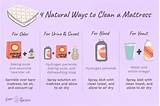How To Clean a Mattress: A Guide to a Fresher, Cleaner Sleep
A clean mattress is crucial for a healthy and comfortable sleep. Dust mites, sweat, dead skin cells, and spills can accumulate over time, impacting your sleep quality and potentially triggering allergies. This comprehensive guide will walk you through various methods to effectively clean your mattress, ensuring a fresh and hygienic sleeping environment.
Understanding Your Mattress Type
Before diving into cleaning methods, identify your mattress type. Different materials require different cleaning approaches. Common types include:
- Innerspring: These mattresses have coils and require careful cleaning to avoid damaging the springs.
- Memory Foam: Known for conforming to body shape, these mattresses need gentle cleaning to preserve their structure.
- Latex: Naturally hypoallergenic, latex mattresses are durable but require specific cleaning solutions.
- Hybrid: Combining different materials, these mattresses require a tailored cleaning approach depending on their composition.
Preparing for Mattress Cleaning
Before you begin, gather your supplies. You'll need:
- Vacuum cleaner with upholstery attachment: Essential for removing surface dust and debris.
- Baking soda: A natural deodorizer and stain remover.
- Spot cleaner (optional): For treating specific stains. Choose a product appropriate for your mattress material.
- Spray bottle: For applying cleaning solutions.
- Clean cloths or microfiber towels: For wiping and drying.
- Gloves (optional): To protect your hands.
Step-by-Step Mattress Cleaning Guide
Follow these steps for a thorough mattress cleaning:
1. Strip the Bed
Remove all bedding – sheets, blankets, pillowcases, mattress protector – and wash them according to their care instructions.
2. Vacuum Thoroughly
Using the upholstery attachment, vacuum the entire mattress surface, paying close attention to seams and crevices. This removes loose dust, dead skin cells, and other debris. Vacuum both sides of the mattress.
3. Sprinkle with Baking Soda
Generously sprinkle baking soda over the entire mattress surface. Baking soda is a natural odor absorber and helps to neutralize unpleasant smells. Let it sit for at least 30 minutes (or longer for stubborn odors).
4. Vacuum Again
After the baking soda has absorbed odors, vacuum the entire mattress again to remove the baking soda residue.
5. Address Stains (Optional)
If you have specific stains, treat them with a suitable spot cleaner. Always test any cleaning solution in an inconspicuous area first to ensure it doesn't damage the mattress fabric. Blot (don't rub) the stain with a clean cloth, working from the outside in. Allow the area to air dry completely.
6. Air Out the Mattress
After cleaning, open windows or use fans to air out the mattress completely. This helps to prevent mildew and mold growth.
Maintaining a Clean Mattress
Regular maintenance is key to keeping your mattress clean and fresh:
- Use a Mattress Protector: This is your first line of defense against spills, stains, and dust mites.
- Air Out Your Mattress Regularly: At least once a week, strip the bed and let the mattress air out for a few hours.
- Vacuum Regularly: Vacuum your mattress at least every three months.
- Spot Clean Immediately: Address spills and stains as soon as they occur to prevent them from setting.
Choosing the Right Cleaning Products
Avoid harsh chemicals and bleaches, which can damage your mattress and cause irritation. Opt for natural solutions like baking soda or mild, mattress-safe cleaners.
By following these steps and incorporating regular maintenance practices, you can ensure your mattress remains clean, fresh, and conducive to a healthy, restful sleep. Remember to always check the manufacturer’s cleaning instructions for your specific mattress type.
